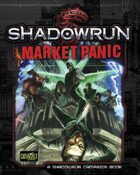

Variant: King of the Hill: With a slight modification, this system can be used to simulate a “king of the hill” scenario where both sides of the conflict are attempting to take and hold the same location. When the track is full, the PCs are overrun by the enemy. For each failure against the Opposition, mark a box along the track.
#Shadowrun 5 pdf reddit bullets and bandadhes Pc#
For each PC who fails, that PC takes stress, trauma or injury depending on the damage system you’re using and how deadly your game is overall (I’d personally not recommend immediately applying damage that takes significant time to heal unless your setting has ways to circumvent that-magic or tech-or this defensive action takes place as part of the climax of the story where the stakes need to be turned all the way up.)Īssign the PCs their own track that represents their ability to hold their position. In each turn, each player character rolls the appropriate pool against the Opposition Pool. 6), if the conflict doesn’t end on the first post-turn roll, in the second turn you roll d6 vs. For each time this die is rolled and does not meet the threshold, reduce the threshold by one. For example, you could start with a D6 and the conflict ends on a result of 6. Use whatever die size you’d like and start with a chance of occurrence you feel comfortable with given the difficulty of the engagement for the characters. After the predetermined amount of time has run, roll a die at the end of each turn to determine if the event that would end the conflict (air support or reinforcements arrive, another team manages to destroy the attackers’ path to the characters, etc.) occurs.


To do this, decide upon a definite number of turns the conflict will last (e.g. Variant: Random Timing: If you want to add additional drama (and stress to your players), you can take a cue from miniature wargaming and have the conflict last for a random number of turns. If the conflict is a matter of holding out for time, you can set up a track or a “clock” in the style of Powered by the Apocalypse games. Depending on your damage system, the enemy force may have a die step that is whittled down, may have a Stress or Trauma die that is stepped up, or may have a damage track. The second preparatory item is a mechanism for tracking the enemy’s fighting ability or the amount of time the PCs must hold out before help arrives. If the size of the attacking force warrants it, consider using the Scale rules, but bear in mind genre as well as the close narrative-if you’re playing a game involving special operations forces in an 80’s-style action movie, they’re probably expected to absolutely wade through the enemy and Scale would not be appropriate. Create this as you would any opposition, starting with a pair of difficulty dice representing the base quality of the attackers and adding dice for a Distinction and other applicable Traits. The first is the dice pool used to represent the attacking force. The GM needs two things at the start of the engagement (which can be set in adventure prep).

This system can be used for situations where the characters are fighting a defensive battle against waves of attackers while keeping mechanics streamlined compared to character-by-character combat. In this part of the series, I’m going offer two (sub)systems for handling particular types of combat situations the first riffs off of the “Bloody Versus” while the second utilizes a nuanced form of “Narrative Combat.” Let’s get to it: For the previous part of this series, click here.


 0 kommentar(er)
0 kommentar(er)
